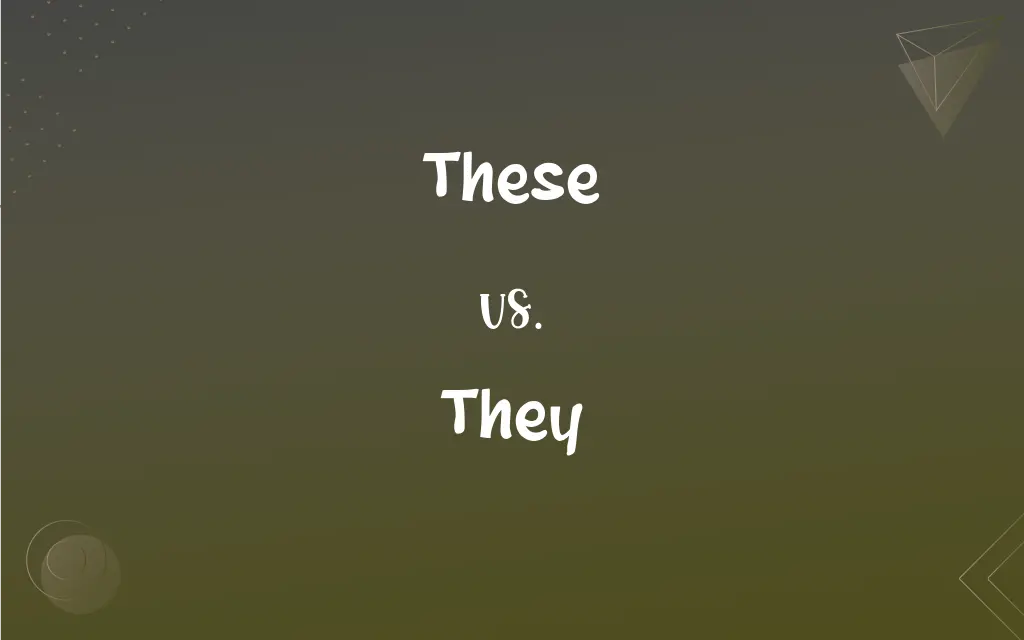These vs. They: What's the Difference?
By Janet White || Published on December 12, 2023
"These" is a demonstrative pronoun used to identify specific items near the speaker; "they" is a personal pronoun referring to previously mentioned or known people or things.

Key Differences
These is a demonstrative pronoun, used to refer to specific items close in proximity to the speaker. It implies a certain closeness or immediacy. They, as a personal pronoun, refers to people or things previously mentioned or understood from the context, without indicating proximity.
In usage, these specifically points to a group of items or people that are near the speaker, often accompanied by a gesture or indication. They, however, is used to refer to a group of people or things in a general sense, without a necessary indication of proximity or visibility.
These often precedes nouns in a sentence, modifying and specifying them. For instance, "these books" indicates specific books close at hand. In contrast, they replaces nouns, standing in for the names of people or things, as in "they left early", where "they" represents certain people.
The use of these can also imply a visible presence or immediate relevance, such as in a presentation or display. They, on the other hand, is less specific about the spatial or situational context of the referenced group, focusing more on the group itself rather than their location or immediacy.
These is particularly useful in distinguishing between items or groups in comparative situations, emphasizing closeness or direct involvement. They, however, is more general and can be used in a wide range of contexts, without the implication of closeness or directness.
ADVERTISEMENT
Comparison Chart
Pronoun Type
Demonstrative pronoun
Personal pronoun
Reference
Specific items near the speaker
People or things previously mentioned
Proximity Implication
Close in proximity
No proximity implication
Usage in Sentences
Often precedes and modifies nouns
Replaces nouns and stands on its own
Contextual Implication
Visible presence or immediate relevance
General reference without specific location
ADVERTISEMENT
These and They Definitions
These
These refers to a specific group of items or people near the speaker.
These cookies are the ones I baked.
They
It represents people or things previously mentioned.
I met the neighbors; they seem nice.
These
It's used to identify particular items in close proximity.
Look at these pictures on my phone.
They
It's a pronoun replacing specific names or nouns.
The cats are hungry; they need to be fed.
These
These emphasizes closeness or direct involvement.
These are the moments I cherish the most.
They
They is used to refer to a group of people or things.
They went to the movies last night.
These
It differentiates between near and far items or groups.
These apples are fresh, those are not.
They
They can indicate an unspecified group.
They say it's going to rain tomorrow.
These
These is often used in presentations or displays.
These charts show our quarterly growth.
They
They is versatile and used in various contexts.
They have been working on the project for months.
These
Plural of this
They
(the third-person plural nominative) A group of entities previously mentioned.
Fred and Jane? They just arrived.
Dogs may bark if they want to be fed.
Plants wilt if they are not watered.
I have a car and a truck, but they are both broken.
These
Plural of this
These
The plural of this. See This.
FAQs
What is the primary function of these?
To refer to specific items or people near the speaker.
How is they used in a sentence?
As a pronoun to refer to people or things mentioned earlier.
Does these imply visibility of the items?
Often, yes, it implies the items are visible or present.
Can they be used for abstract concepts?
Yes, it can refer to abstract groups or entities.
Is the usage of these limited to physical proximity?
Primarily, but it can also imply metaphorical closeness.
Can these be used for distant objects?
No, it's for items or people close to the speaker.
Is they always plural?
Traditionally yes, but it can also be singular in gender-neutral usage.
How does they function in a narrative?
It refers to characters or items previously introduced.
Does the use of these change in formal writing?
The usage remains the same but might be less frequent.
What is the singular form of they?
Traditionally "he" or "she," but "they" is also used as singular now.
Is they gender-specific?
No, it's gender-neutral.
Can these refer to people?
Yes, it can refer to a specific group of people nearby.
Is there a singular form of these?
Yes, "this" is the singular form.
Can they refer to an individual?
Yes, especially for gender-neutral references.
Can these be used in comparisons?
Yes, it's often used to compare nearby items with distant ones.
Is there a possessive form of these?
No, these is only used as a demonstrative pronoun.
Is they used in formal or legal contexts?
Yes, it's commonly used in various contexts, including formal.
What is the possessive form of they?
"Their" is the possessive form of they.
How does context affect the use of these?
It's used based on the proximity and presence of the items or people.
Can they be used to refer to animals?
Yes, it can refer to groups of animals.
About Author
Written by
Janet WhiteJanet White has been an esteemed writer and blogger for Difference Wiki. Holding a Master's degree in Science and Medical Journalism from the prestigious Boston University, she has consistently demonstrated her expertise and passion for her field. When she's not immersed in her work, Janet relishes her time exercising, delving into a good book, and cherishing moments with friends and family.

































































